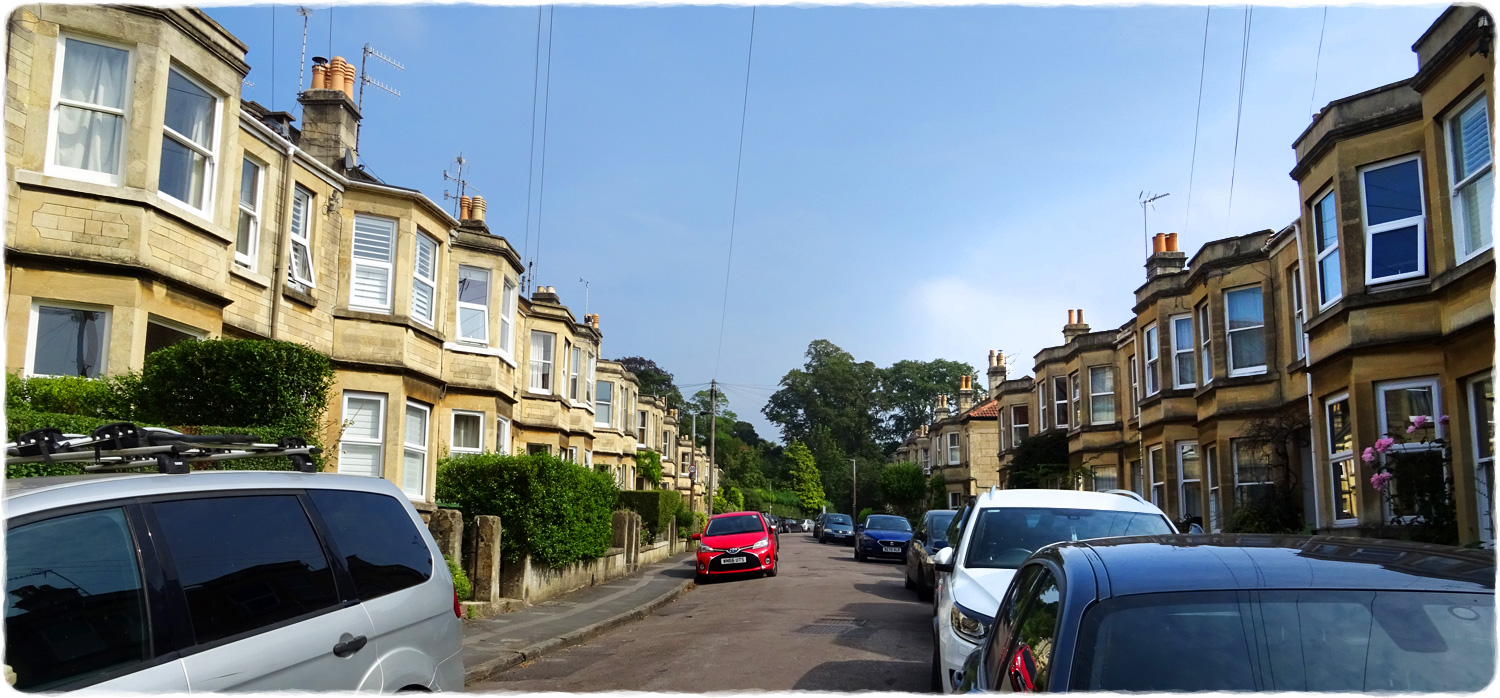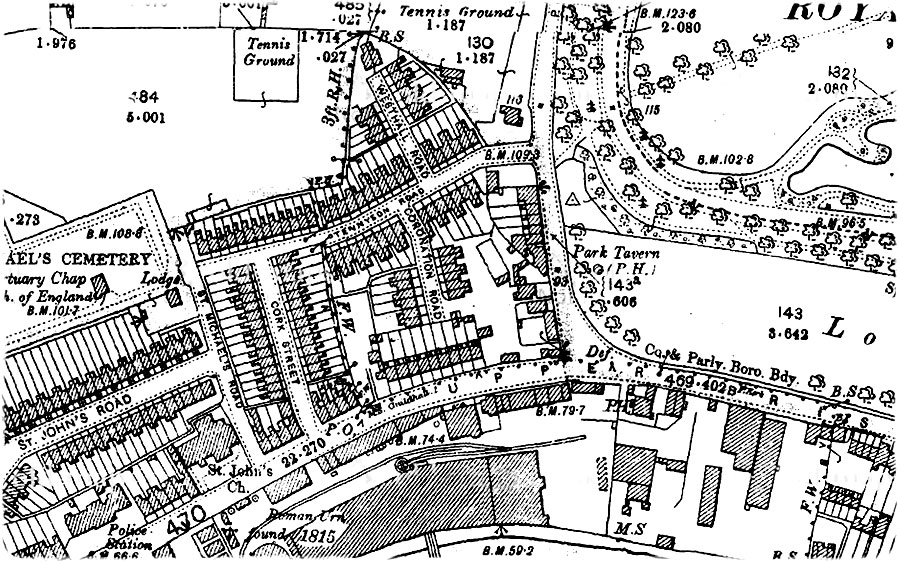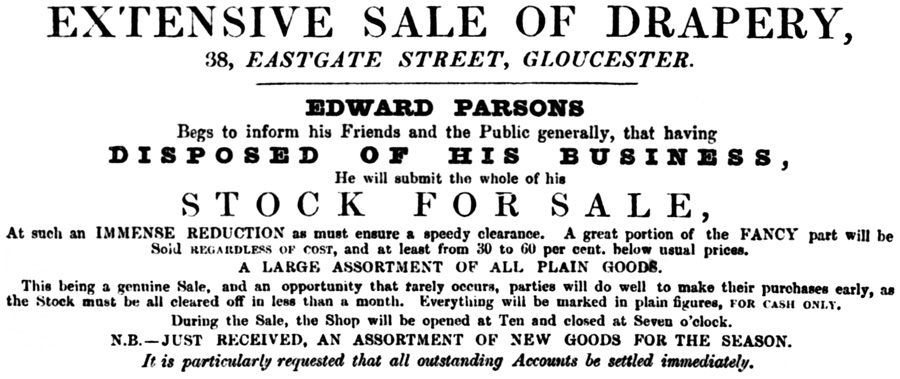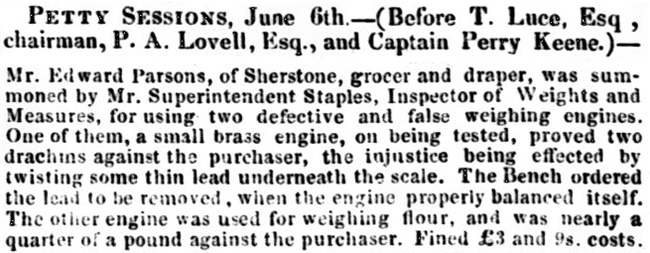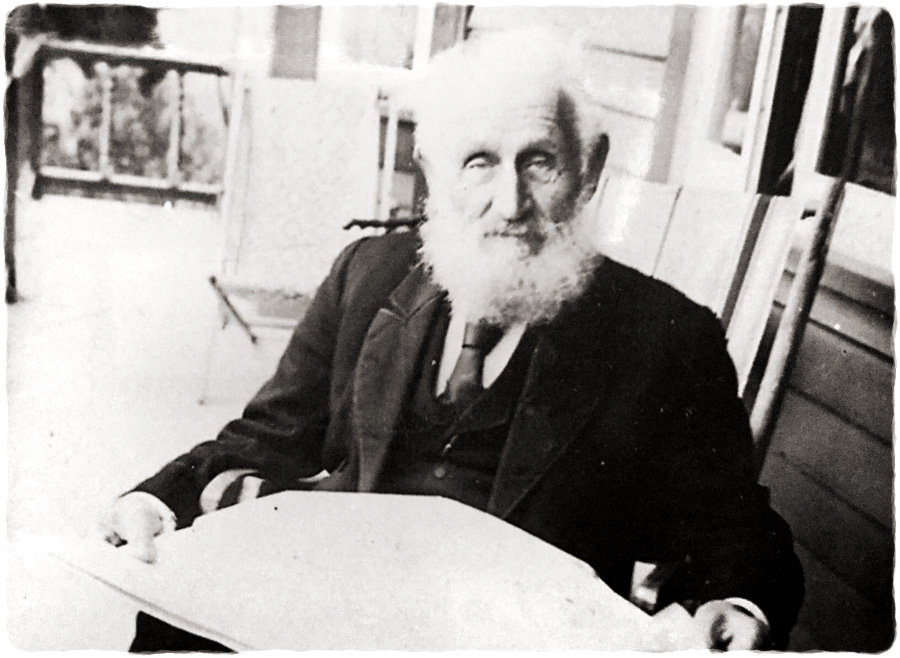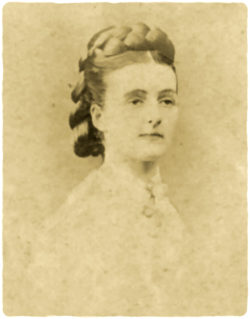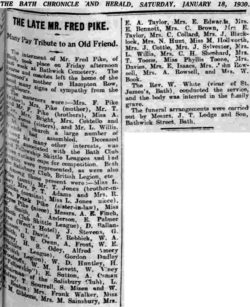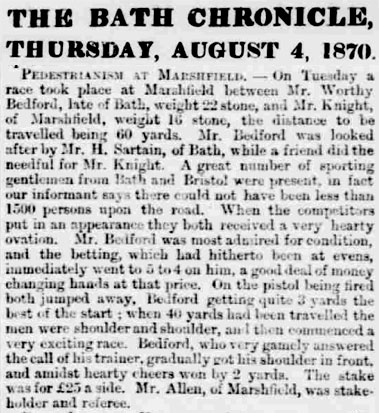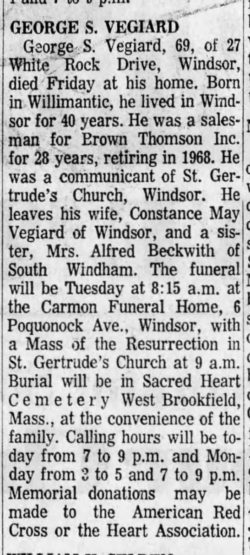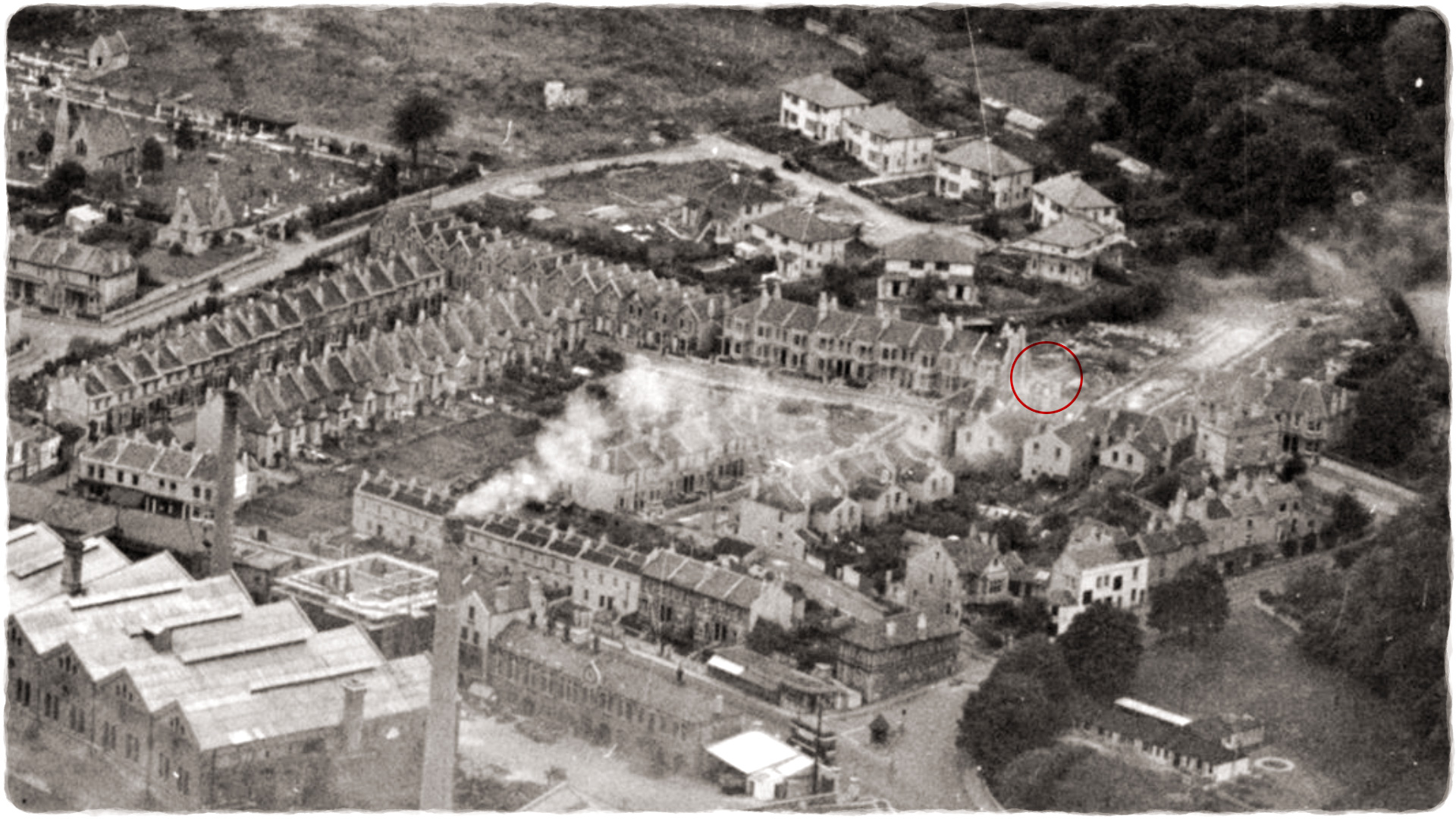INTRODUCTION
The houses along Tennyson Road in Bath were built in 1897 on land leased from St. John’s Hospital. The contract began on 21st December 1895 for 499 years, and 33 houses were built in total. Using census and electoral records, it is possible to trace the occupants of 7 Tennyson Road from 1899 to 1939, three years before it sustained serious war damage and was rebuilt, more or less covering its existence in its original form.
This black and white photograph of Tennyson Road was taken in 1905. Number 7 is slightly higher up the road from where the boy is walking.
- Tennyson Road (1905)
- Tennyson Road (2021)
These two maps, from 1888 and 1904, show how the area was transformed from an orchard into streets.
- Map 1888
- Map 1904
Residents: 1899-1939
- 1899-1907 – Census records and the electoral register show Edward PARSONS and ELIZABETH C. PARSONS were living at 7 Tennyson Road during this period.
- 1908-1909 – 7 Tennyson Road is not listed in the electoral register between. All other houses on either side were listed.
- 1910-1912 – Records show Frederick DAY and Laura DAY resided at 7 Tennyson Road.
- 1914 – The electoral register lists Harriet PUTTICK at 7 Tennyson Road.
- 1915-1917 – 7 Tennyson Road is not listed in the 1915 electoral register. All neighbouring houses were listed. No registers were taken between 1915 and 1917.
- 1918-1922 – Emily MEREDITH appears in the electoral register during this time.
- 1923-1924 – Walter Thomas DAVIS and Alice M. DAVIS are listed at the address.
- 1924-1925 – Frederick PIKE and Alice M. PIKE are recorded as residents.
- 1926-1927 – The house is not listed in the electoral register. All surrounding houses were recorded. Both the Pikes (above) and the Colemans (below) had moved elsewhere.
- 1928-1931 – The electoral register shows Frank D. COLEMAN, Minnie COLEMAN, William H. COLEMAN and Worthy COLEMAN living at 7 Tennyson Road. The available online register ends in 1931, so it is unclear how much longer they lived there.
- 1932-1938 – Electoral registers for this period are not available online, so the residents during these years are unknown.
- 1939 – The 1939 Register lists four residents at 7 Tennyson Road: Esther LOCK, Lilian E. LOCK, Frederick J. PARKER and Constance M. STEVENS (surname “VEGIARD” was added later). These may have been the last people to occupy the original house before it was destroyed in 1942.
1899 to 1907 – Edward PARSONS & Elizabeth Caroline MEDDICK
Census and electoral records show that Edward PARSONS and ELIZABETH C. PARSONS were living at 7 Tennyson Road between 1899 and 1902, and just Elizabeth from 1903 to 1907 (and likely into 1908). They may have been the first residents of the property after its construction.
Edward PARSONS was born on 14th November 1819 in Greinton, Somerset, the seventh of eight children born to Quaker parents Isaac PARSONS and his second wife, Mary BAGWELL. Edward had a hard childhood: his eldest sister died on 24th March 1826 (aged 13), followed by his mother on 31st May 1828 (aged 43) and his father in June 1830 (aged 65). It is unknown who cared for the orphaned children, who were aged between 7 and 18.
Edward has not been identified in the 1841 census (aged 21), but by 1851, he was working as a draper and residing at 38 Eastgate Street, Gloucester. In his employ were John WILTSHIRE (a journeyman draper), Maria POMEROY (an apprentice draper) and Isabella FREEMAN (a house servant).
- Gloucester Journal (10 April 1858)
Aged 33, Edward married his first wife, Ann BUCKINGHAM (25), on 17th August 1853 at St. Michael’s Church, Gloucester, having left the Quakers. Ann, the daughter of a corwainer, was about ten years his junior. The couple had two children in Gloucester before moving to Sherston Magna, Wiltshire, in 1858, where Edward expanded his business into a draper’s and grocer’s shop. Ann gave birth to their third child in 1860 in Barton, Gloucester, likely at her mother’s house.
The 1861 census records Edward residing on Sherston High Street with his 4-year-old daughter Alice and two servants. Ann was visiting her sister in Warwickshire, accompanied by their 1-year-old son William, whilst their eldest child, Margaret, stayed with her grandmother in Barton. Shortly after the census, Edward was charged with using two defective weights and false weighing engines and fined £3 and 9s costs.
- Wilts and Gloucestershire Standard (15 June 1861)
Tragically, Ann died on 15 January 1864, aged 35, possibly due to complications after the birth of their fifth child, Beatrice.
- Margret Annie Parsons (1854-1935) – m.1876 to master saddler and registrar of births, marriages and deaths Frederic Saunders
- Alice Elizabeth Parsons (1857-1924) – m.1880 to draper Walter James Manser Dicks
- William Edward Parsons (1860-1932) – m.1889 to Ruth Young; clerk at HM Customs
- Elizabeth Bagwell Parsons (1861-1943) – m.1906 to draper Henry Partlow Clark
- Beatrice Mary Parsons (1863-1872) – died aged 8
Three years later, on 10th April 1867, Edward married 45-year-old spinster Elizabeth ROWE at the Independent Chapel, Weston-super-Mare. Elizabeth, the daughter of a cordwainer (shoemaker), assisted Edward in the drapery business.
Edward continued working as a draper and grocer, and in 1871 was assisted by two employees, a governess, and a servant. His youngest daughter, Beatrice (age 7), was lodging with another family in Sherston, who had likely taken her in as a newborn after her mother’s death. She sadly died the following year, aged 8.
In 1881, Edward was recorded as a visitor at 4 George Street, Stroud, in the household of Susan SMITH, a grocer. The street was lined with drapers. Meanwhile, the family home was at 1 Victoria Quadrant, Weston-super-Mare, where Elizabeth died on 15th January 1884, aged 62. The following year, Edward sold all his household furniture, possibly moving to Cheltenham.
In 1888, Edward married for the third and final time, to Elizabeth Caroline LLOYD (née MEDDICK), a widow fourteen years his junior.
Elizabeth Caroline MEDDICK was born in the spring of 1834 in Walcot, Bath, the second of eight children of John MEDDICK and his wife, Sarah STILL. Her father, a cordwainer, died in February 1853 at 1 Trinity Street, Walcot, when his youngest child was just three. In 1861, Elizabeth (aged 27) was unmarried, living at home (8 Kingsmead Terrace, Bath), and working as a milliner and dressmaker. By 1871, she was head of the household at 4 Old King Street, Bath, living with two sisters and still working as a dressmaker. In 1880, she married the twice-widowed Robert LLOYD, a retired farmer aged 65. Elizabeth was 46. Their marriage lasted five years until Robert’s death in Sherston Magna on 30th December 1885.
Elizabeth remained in Sherston Magna after the death of her first husband and married Edward on 2nd Aug 1888, at the Congregational Church, Malmesbury (5 miles away). They were recorded in the 1891 census, still residing in Sherston. Edward was now 71 and retired; Elizabeth was 55.
Between 1896 and 1899, the couple moved to 7 Tennyson Road, where Edward remained until his death on 17th April 1902, aged 82. Elizabeth stayed until at least 1907. When she died on 13th March 1909, aged 75, she had been living at 3 Berkeley Place, Camden Road, Bath, with her niece, Elizabeth Caroline GADD (née MEDDICK). Her death notice described her as “late of Tennyson Road.”
- Edward Parsons (1890s)
1910-1911 – Frederick Martin DAY & Laura TREASURE
Census and electoral records show that Frederick Martin DAY and Laura DAY were living at 7 Tennyson Road between 1910 and 1911.
Frederick Martin DAY was born on 16th December 1882 in Creech St Michael, Somerset, the third of six children of William DAY, an innkeeper, and his wife, Florence Ellen MEAD. His father ran the Star Inn in Adsborough and later the Star Inn in Thurloxton (now the May Inn).
Laura TREASURE was born on 14th May 1884 in Stoke St Michael, Somerset, the fifth of eleven children of Theodore TREASURE and Hannah ROSSITER. Her father, an innkeeper and haulier, ran the Waggon & Horse Inn in Doulting and later the Three Ashes in Stoke St Michael. Her mother bore a child approximately every two years from 1876 to 1896. In December 1897, the Female Industrial Sub-Committee awarded Laura one of forty studentships to the School of Cookery and Housewifery in Street. It was tenable for six months and included free tuition, board and lodgings. By 1901, aged 16, she was working as a general domestic servant for a governess running a small private school in Pokesdown, Hampshire.
Frederick has not been identified in the 1901 census, when he would have been 18. He later moved to Bath and was living at 30 Tennyson Road, working as a butcher, when on 11th January 1906, he was summoned to court for cruelly ill-treating a horse by beating it with a whip and furiously driving a horse and cart in St. James Street. Witnesses, including a police constable and an N.S.P.C.A. inspector, corroborated the mistreatment, noting blood visible on the horse and Frederick’s admission of striking the animal. He claimed it was sluggish and wouldn’t go without being whipped, and that he only struck it because it wanted to go the wrong way. The Magistrates fined him 5 shillings or 7 days for furious driving and 20 shillings or 14 days for ill-treatment, and commended Inspector Doyle for bringing the case forward, due to increasing concerns about fast driving and animal mistreatment.
In early 1907, Frederick (25) married Laura (22). Depending on the date of their marriage, she was either heavily pregnant with or had just given birth to their first child. A second child followed in 1908.
- Phyllis Dorothy Day (1907-1999) – m.1940 to Wilfred Cecil Malin
- Gladys Evelyn Day (1908-1999) – m.1935 to master carpenter and joiner Reginald Cuthbert James Weeks
The family moved into 7 Tennyson Road around 1910 and lived there until 1911 (likely into 1912). The 1911 census recorded Frederick’s occupation as “butcher” and noted that he was a “worker.” Also present was Edith PHILIP, a 51-year-old unmarried visitor with no listed occupation. She had previously worked as a kindergarten teacher and was the daughter of Emily PHILIP, who briefly lived at 28 Tennyson Road in 1911.
By 1912, the Day family had moved just around the corner to 7 Westhall Road, and by 1914, next door to 6 Westhall Road. No military records have been found for Frederick, who by 1921 was unemployed. His two youngest brothers enlisted at the outbreak of war, as did one of Laura’s brothers:
- Albert DAY (Sergeant, Royal Tank Corps) was killed in action or died from wounds shortly after 1st December 1917 during the battle of Cambrai, aged 30
- Wilfred DAY (Corporal, Motor Transport Company) died of tuberculosis on 12th February 1919 (caught during 1917), aged 27
- Alban TREASURE (Lance Corporal MM, Machine Gun Corps) died just two days before Armistice, on 9th November 1918, aged 31
In 1935, Gladys married master carpenter Reginald Cuthbert James WEEKS at Holy Trinity on Monmouth Street, Bath. The three remaining Day family members were still living at 6 Westhall Road when the 1939 Register was taken. Frederick was recorded as a “butcher assistant,” Laura as performing “unpaid domestic duties,” and their 23-year-old daughter Phyllis was working as a dressmaker. She married the following year at Holy Trinity to Wilfred Cecil MALIN.
Frederick died in late 1953 in Bath, aged 70. Laura died two years later, on 15th April 1955, at The Manor Hospital, Bath, also aged 70. Her probate record lists her last address as being in Shepton Mallet. Their daughters died within weeks of one another in 1999; Phyllis in Shepton Mallet (aged 92), and Gladys in Solihull, Warwickshire (aged 91).
1914
The electoral register lists Harriet PUTTICK residing at 7 Tennyson Road in 1914.
Harriet PUTTICK, née THURGOOD
Harriet THURGOOD was born on 13th May 1857 in Billericay, Essex, the second of four children of Thomas THURGOOD and his wife, Harriet ARCHER. Her father worked as an iron founder, and her maternal grandfather, Richard ARCHER, was a butler to John Tyssen TYRRELL, Baronet and magistrate. Two of her uncles also worked for him, while another uncle was a police constable.
Harriet married widower Frederick Valentine PUTTICK on 12th July 1886, in St. George Hanover Square, London. Frederick had a 9-year-old son from his previous marriage to Alice WHITE (1853-1880).
The couple had four children, all born in Colchester, Essex, where Frederick was employed as a grocery manager.
- Margarette Puttick (1887-1959) – unmarried; kindergarten teacher and school principal
- Frank Valentine Puttick (1888-1926) – unmarried; emigrated to New Zealand by 1911; farm labourer and shepherd
- Claude Henry Puttick (1890-1965) – m.1917 in New Zealand to Mildred Emma Read; farming
- Florence Muriel Puttick (1892-1982) – m.1920 to police sergeant and county court bailiff Fredrick Augustus Quinn
In 1899, Frederick gave up work due to ill health. After a break, he took on a managerial role in Sudbury, Suffolk. The 1901 census recorded the family living at 22 King Street, with Frederick’s occupation listed as “grocery, wine and spirit merchant (shopkeeper).” His mother was living with them, along with a general domestic servant.
In July 1902, Frederick began a new venture as a fishmonger and poulterer under the name “Puttick and Sons,” though both sons were minors and not involved. The business was short-lived; he was declared bankrupt in January 1903. He had kept no financial records, and cited a lack of trade knowledge, setup costs, and insufficient custom for the business’s failure.
By 1904, the family had moved to 14 Newbridge Road, Bath, and later to 42 Newbridge Hill. Both properties were secured by Harriet ahead of their move. When the 1911 census was taken, Harriet was working as a boarding house keeper, living with her youngest daughter, Florence, two servants, and one boarder. Frederick, who had no occupation, was living in London with his widowed brother Thomas, a former stonemason turned licensee of the Jolly Gardener in Wandsworth. Barely three weeks later, on 26th April, Frederick died at his brother’s house, aged 61.
By 1914—possibly as early as 1912—Harriet and Florence had moved to 7 Tennyson Road. Margarette was working as a kindergarten teacher in Kensington and lodging with relatives. Frank and Claude had emigrated to New Zealand by 1911 and, when war was declared, both enlisted: Frank joined the Otago Mounted Rifles as a trooper, and Claude the Medical Corps as a private. Frank was wounded on 13 July 1915 and returned to New Zealand in 1916. Claude was declared unfit for service on 25 June 1916 and also returned. He married Mildred Emma READ the following year.
By 1918, Harriet had moved to 55 Bassett Road, Kensington, where she and Margarette were living when the 1921 census was taken. Florence, recently married, was visiting with her two-month-old son. Her husband, Frederick Augustus QUINN, had served as a corporal during the war with the Army Service Corps.
On 23rd April 1926, Frank tragically died by suicide (gunshot wound), aged 37.
In the 1939 Register, Harriet (aged 83) was living in Kensington with her grandson, John Edward QUINN (18), who worked as an editorial assistant. Margarette (unmarried, aged 52) was living in Horsham, Sussex, working as a school principal. Harriet moved to Southsea, Hampshire, shortly after, where Florence lived with her family. Her husband, Frederick, was a retired Portsmouth City Police sergeant and County Court bailiff.
Harriet died in Portsmouth in early 1946, aged 89. Margarette died in Chichester in mid-1959, aged 72. Claude died on 12th March 1965 in Auckland, New Zealand, aged 74. Florence died in 1982, aged 89.
1915-1917
There were no registers taken between 1915 and 1917.
1918-1922
Census and electoral records show that Emily MEREDITH and her servant, Ellen DEVERELL, lived at 7 Tennyson Road between 1918 and 1922.
Emily MEREDITH
Emily MEREDITH, full name Emily Ap Williams MEREDITH, was born on 24th July 1846 in Toronto, Ontario, Canada, the sixth of eight children of Joseph MEREDITH, a dentist and civil servant, and his wife, Ellen Williams.
Joseph was born on 31 July 1805 in Birmingham, the son of James MEREDITH, a varnish manufacturer. His wife, Ellen, was born in 1807 in Bagillt, Flintshire, Wales. In traditional Welsh patronymic naming, the prefix ap denotes “son of,” while ferch denotes “daughter of.” However, James and Ellen applied the ap prefix to all their children’s names, regardless of gender. It is unclear whether the couple married before leaving for Canada or met and married in Ontario, where they had seven children between 1831 and 1849 (losing their first).
In 1851, the family made the long journey back to England and settled in Edgbaston, Warwickshire, just in time for the birth of their eighth and final child.
- Sarah Ap Williams Meredith (1831) – died in childhood, before 1843
- Ellen Ap Williams Meredith (1836-1924) – unmarried; Sister of Mercy
- Winifield Ap Williams Meredith (1840-1935) – m.1863 to merchant Edward Brooke-Smith; lived in South Africa and New Zealand
- Sarah Ap Williams Meredith (1843-1931) – m.1883 to civil engineer Alfred Bache
- James Ap Williams Meredith (1845-1868) – unmarried; died in Kinsembo, Congo, aged 23
- Emily Ap Williams Meredith (1846-1944) – unmarried; no occupation
- Alfred Ap Williams Meredith (1849-1939) – m.1873 to Ann Hubbert; bedding manufacturer (upholsterer)
- Joseph Ap Williams Meredith (1851-1898) – m.1890 to Marshink Augusta Clara Grubb; banker’s clerk
Emily has not been located in the 1861 census. She would have been 14 years old but was not at home with her family at 16 Duchess Road. Elsewhere, her eldest sister, Ellen, had become one of the first members of the North London Deaconesses Institution and was ordained in 1863. On 10th May 1868, her brother James died in Kinsembo, Congo, at the age of 23.
By 1871, the family had relocated south to 12 Grayling Road, Stoke Newington, London, where they employed one domestic servant, Eliza STAMMERS, aged 21. Emily’s father, now aged 65, was retired.
On 11th February 1876, Emily’s mother died at 13 Brownswood Park. Stoke Newington, at the age of 69. The family then moved eight miles east to 21 Church Road, Willesden, where they remained for several years. Only two other siblings lived at home with Emily, along with another domestic servant, Fanny PAVELIN, aged 21. Emily’s sister, Winifred, was now married and living in Port Elizabeth, Eastern Cape, South Africa, with her family.
By the time of the 1881 census, only Emily and her father were living at 21 Church Road, along with their general domestic servant, Ellen DEVERELL, aged 24. Ellen remained with the Meredith family, specifically Emily, for many years. She was born in 1866 in Aston Abbots, Buckinghamshire, the youngest of seven children of Joseph DEVERELL, a shepherd, and his second wife, Phillis BATES. Ellen’s mother died on 2nd February 1889 in Aston Abbotts, aged 63, followed by her 73-year-old father on 28th October 1891, at the Buckinghamshire County Asylum in Stone, where he had been for three weeks.
Joseph MEREDITH died from bronchitis on 20th June 1895, at 33 Madeley Road, Ealing, at the age of 89. By 1901, Emily had moved to Shere, Surrey, where she and Ellen were recorded in the census. Electoral records list Emily at “The Old Rectory, ” North Bradley, Wiltshire, between 1906 and 1915. As a ratepayer (she paid local taxes on her property), she was one of the few women eligible to vote in local elections at this time.
On the night of the 1911 census, Emily was visiting her brother Alfred, a bedding manufacturer, in Hampstead, while Ellen was visiting her sister in Aylesbury, where she was listed as “housekeeper domestic.”
Due to the war, no electoral registers were taken between 1915 and 1917; however, when they resumed in 1918, Emily was registered at 7 Tennyson Road, Bath. The 1921 census recorded that Emily was 74 years and 10 months old, with no occupation, while Ellen was 54 years and 9 months old. Ellen’s relationship to Emily was listed as “servant,” but her occupation was intriguingly noted as “not working for profit.” The pair remained at 7 Tennyson Road until 1922, when the next residents moved in the following year.
On July 23, 1926, Ellen died at Beaufort House in Marshfield, Gloucestershire, at the age of 60. It is unclear whether she was still employed by Emily at that time. By 1930, Emily was living at 2 Kensington (now known as Kensington Place), located north of Bath’s city centre. In June of the following year, she suffered a serious head injury after tripping over an uneven section of the High Street and was taken by ambulance to the Royal United Bath Hospital for treatment.
Emily remained at 2 Kensington Gardens and was recorded there in the 1939 Register at the age of 93, living with six other individuals. The large three-storey house accommodated a retired paper maker foreman, his wife, their 31-year-old son, a hospital nurse, a shop assistant, and one man with no recorded occupation. In 1942, the area sustained damage during the Luftwaffe bombing raids on Bath, and at the age of 95, Emily was forced to leave. She was the last surviving of her siblings and died on 29 August 1944 at the age of 98 at St Michael’s House, Priory Road, Wantage, Berkshire. The property was a large Anglican retreat house operated by the Sisterhood of St Mary the Virgin—the same religious order her sister, Ellen MEREDITH, had joined in the 1890s.
At the time of her death in 1944, Emily’s estate was valued at £222 17s 11d, approximately £8,500 today. By contrast, her servant and companion, Ellen, who died eighteen years earlier, left an estate worth £381 3s 6d (just over £20,000 today). This inversion of financial standing within the traditional servant–employer dynamic is particularly striking. Emily left behind few records detailing how she spent her time, and aside from occasional references to her involvement with summer fairs at the local church in North Bradley, little survives to illuminate the character or rhythms of her long life.
- Emily Ap Williams Meredith (1870s)
- Bath Chronicle (27 June 1931)
- WiltshirenTimes (02 Sep 1944)
1923-1924
Electoral records confirm that Walter Thomas DAVIS and Alice M. DAVIS were residing at 7 Tennyson Road from the spring 1923 through spring 1924. In addition, Ernest CLEEVE was also recorded at the address in spring 1923.
Walter Thomas DAVIS & Alice JACKSON
Walter Thomas DAVIS was born on 17 July 1871 at 9 Kingsmead Terrace, Walcot, Bath, the youngest of eight children of Edward DAVIS, a cabinet maker, and his wife, Eliza WHIDDEN. Two of Walter’s brothers followed their father into the joinery trade—one becoming an organ maker and the other a cabinet maker. Walter, however, took a different path, working as a printer compositor for Pitman & Sons Shorthand Publishers in Bath, where he remained for his entire career.
Alice JACKSON was born on 19 February 1872 in Wotton-under-Edge, Gloucestershire, the second of two children of Llewellyn Frederick Martin JACKSON, a gardener, and Caroline HIGGINSON. Her father was the illegitimate son of Josiah JACKSON, a steam engine driver, and his housekeeper, Ann MARTIN. Ann moved in with Josiah after his wife died, likely to help raise the children, and remained with him until his death in 1867. The two never married and appear to have had only one child together, Llewellyn, who died in 1875 at the age of 29, leaving daughters aged five and three.
Alice’s mother, Caroline, had previously been married and widowed. Her first husband—possibly William CHANT, who died at the end of 1867—has not been formally identified. She remarried in the spring of 1881 to Ambrose WEBB, a former Royal Navy sailor. Ambrose was long employed as manager of The Cripples’ Home (for boys and young men) at 3 Prospect Place, Camden Road, Bath, where Caroline worked as matron. They had one son together (Alice’s half-brother). Ambrose died just before the 1911 census, aged 59, and Caroline in 1923, aged 84.
Walter and Alice married on 30th April 1895 in Charlcombe, Somerset, and had one child.
- Enid Amy Davis (1899-1992) – m.1928 to builder and decorator James Edgar MALE; school teacher
In 1911, Alice’s occupation was listed as “newsagent, stationer and tobacconist (employer),” though the trade directory that year recorded the business under “Thomas Davis.” The family moved frequently within Bath, accompanied by Walter’s mother. They resided at 3 Westhall Road between 1901 and 1903 (next to Tennyson Road), then at 4 Victoria Buildings, Twerton (1907–1911), 5 Ashley Avenue (1912–1919), and 17 Ashley Avenue (1920–1922). Walter’s mother died on 25 July 1922. The family then spent a brief period at 7 Tennyson Road (1923–1924), before settling at 9 Belgrave Crescent, where they were recorded in the 1939 Register.
Alice died in early 1940, aged 67. Walter survived her by over two decades, dying in 1963 at Westleigh, Freshford, Somerset, aged 91. Their daughter, Enid, also lived a long life, passing away in 1992 at the age of 92.
Ernest CLEEVE
Ernest CLEEVE boarded with the Davis family for many years.
Ernest was born in late 1874 in Wiveliscombe, Somerset, the eighth of nine children of Richard CLEEVE, a sawyer and brewer’s labourer, and his wife, Jane GILES. By 1891, he had become a cabinet maker’s apprentice in Wiveliscombe, and by 1911 had moved to Twerton, Bath, to board with the Davis family at 4 Victoria Buildings. Then aged 36 and unmarried, Ernest remained closely associated with them for at least another decade.
By 1918, he had moved to 17 Ashley Avenue, where the Davis family joined him two years later. In 1921, Ernest was operating his own cabinet-making business from Station Road, Weston, while still residing with the Davises. By spring 1923, they had all moved together to 7 Tennyson Road. After that point, Ernest disappears from surviving records.
1924-1925
The electoral register shows Frederick PIKE and Alice M PIKE were living at 7 Tennyson Road between autumn 1924 and autumn 1925.
Frederick John PIKE & Alice Mary WHITEHEAD
Frederick John PIKE was born on 28th May 1892, in Bathwick, Somerset, the fourth of eight children of Alfred PIKE, a police constable, and his wife, Sarah Ann POULSOM.
Frederick grew up at 14 Hampton Row, Bathwick, and in 1910, his oldest sibling, Annie, emigrated to Canada. He followed her over there just after the 1911 census was taken, and was working as a French polisher at the time. He returned to England in late 1913 and headed back to Canada in January 1914, now working as a machine hand.
On 25th Sep 1914, Frederick enlisted in the Canadian Field Artillery and was promoted to bombardier in the field in May 1915. He became ill with pleurisy in February 1916, just before being promoted to corporal, and a few months later to sergeant (both in the field). He became ill again with pleurisy in 1917 and was also treated for syphilis, which he had contracted prior to enlistment. Then, in January 1918, he became dangerously ill with pneumonia, from which he slowly recovered.
Frederick returned to Canada on 31st Dec 1918 and was officially discharged on 27th Jan 1919. He was awarded the Military Medal. He remained in Canada until the end of the year, when he returned to England to his family home in Bathwick, where he became a commission agent.
Frederick’s father died in 1921, and in 1922, he married Alice Mary WHITEHEAD.
Alice Mary WHITEHEAD was born on 12th April 1881 in Southport, Lancashire, the fifth of six children of John William WHITEHEAD, a printer compositor, and his wife, Eliza Anne ORDISH. Alice grew up in Southport, so how did she meet Frederick? On tracing her siblings, her sister Fanny married Leonard Ewart DEWEY in 1912, in the Ormskirk district of Lancashire. In 1911, Leonard was living in Bath, working as an optician’s manager. He was sent to work in the Southport branch of Curry and Paxton, where he met and married Fanny before moving back to Bath. The couple adopted a 1-month-old baby in January 1916 and were living at 35 Paragon, Bath, from 1918. It seems likely that Alice visited her sister in Bath and met Frederick sometime between 1919-1922.
Frederick and Alice married in 1922 in Bath and lived at 7 Grosvenor, Walcot, between 1922 and 1923. In 1924, they moved into 7 Tennyson Road, where they remained until 1925. From 1926 to 1929, they lived at 4 Pulteney Avenue, and in 1930 at St Mary’s Buildings, Wells Road. They didn’t have any children, and Frederick died suddenly on 7th January 1930 at age 37. An article about his funeral notes that he was part of the Bath Club and Fellowship Skittle Leagues.
Alice remarried the following year to the recently divorced Walter Stanley LOADER; they didn’t have any children together. Alice and Walter died within four months of each other in 1979 in Bath. Alice was 88, and Walter was 86.
- Bath Chronicle 11th Jan 1930
- Bath Chronicle 18th Jan 1930
1926-27
7 Tennyson Road is not in the electoral register between 1926 and 1927, and the previous residents (Pikes) and next residents (Coleman’s) were listed elsewhere. All other houses on either side were listed. Either the house was empty, or whoever was living there wasn’t eligible to vote.
1928-1931
The electoral register shows Frank D COLEMAN, Minnie COLEMAN, William H. COLEMAN and Worthy COLEMAN were living at 7 Tennyson Road between 1928 and at least 1931.
Henry William COLEMAN & Minnie Angela BEDFORD
William Henry COLEMAN, a Tailor’s Manager, was born in 1880 in Hoxton, Middlesex and was the third of seven children born to William Henry COLEMAN (a Tailor’s Cutter) and Elizabeth GOUGH (a Tailoress). The family moved around a bit as his parents were from Bristol, where they had their first child, then they moved to London, where they had two more children, and then onto Walsall in Staffordshire, where the last four children were born.
Minnie Angela BEDFORD was born in 1874 in Wolverhampton, Staffordshire and was the first of six children born to parents Worthy BEDFORD and Ada Emily BEDFORD (1st cousins). Worthy was a farmer, maltster and licensed victualler, as was his father before him. Both Worthy and Ada were from Marshfield, Gloucestershire, and only Ada was born in Staffordshire. Their second child was born in Bristol, and the last four in Swainswick, Somerset. But this is the least of the stories to piece together!
Her father, Worthy BEDFORD, was born in 1833 in Marshfield, Gloucestershire and married his first wife, Marianne Elizabeth ROBINSON, when they were both just 17. They had four children together between 1852 and 1857, and in 1861, Worthy was working as a farmer of 160 acres (employing six men and three boys). Then, in 1864, Worthy petitioned for divorce from his wife on the grounds of adultery with one Robert Clement Matthews and one William Osborne. The accusations were denied by all involved, and Marianne replied with a long list of violence her husband had caused her. She stated he beat her with a riding whip and his fists, attempted to strangle her and even threatened to shoot her with a loaded gun. This was all alleged to have happened between 1852, just after they were married, right until the year of the petition. She also gave the names of two women Worthy himself had committed adultery with (Elizabeth Lloyd at 13 Milk Street, Bath, and Victoria Hancock at 3 Milk Street, Bath). He also committed adultery with unknown women at 7 Little Corn Street and 7 Monmouth Street, Bath. The case lasted nearly a year and a half and went to court several times, with witness statements from both sides. Marianne requested custody of their daughter Harriet, and Worthy had to pay her court fees of £82 5s & 8d, but their marriage was not dissolved as she filed for divorce herself on the grounds of adultery and cruelty in 1869 (no indication within the papers if it was granted). Marianne is nowhere to be found in census records after this point.
In 1870, I found a newspaper article mentioning Worthy Bedford as taking part in a 60-yard race around Marshfield, which attracted quite a crowd. He was described as “weight 22 stone“.
- Bath Chronicle 4th Aug 1870
In 1871, Worthy’s eldest son was living with an uncle (Worthy’s brother), and his daughter was living with an aunt (Worthy’s sister). His other two sons were living with him (who stated to still be married), and they were all living with Worthy’s mother. Amongst the household was his cousin Ada, age 24, with whom he then started a relationship (their first child, Minnie, born in 1874).
In 1881, her father was running the Bladud Arms in Swainswick, Somerset, but the two oldest children were missing (Minnie and Ernest). Ernest was boarding at age 5 with the Haines family (unrelated). Minnie has not been found anywhere, nor in 1891. Why was Minnie born in Staffordshire? There are no links to the place on either parent’s side, so could it have been work-related? Where was she in 1881 and 1891, and could this help explain how she met her future husband, who himself grew up in Staffordshire?
In 1891, Worthy was running the Railway Inn in Avon Buildings on Lower Bristol Road, Twerton. Worthy and Ada didn’t get married until 28th May 1895 (their eldest daughter, Minnie, was 21 by then), and he states to be a widower at this point. Four days later, he died (1st Jun), aged 62. On his death, his wife Ada took over the Railway Inn briefly until her death in 1900, and then their son Ernest ran it until 1906.
William and Minnie married on 12th Dec 1900 in Twerton, Bath. In 1901, the couple were living with Minnie’s brother at 13 Avon Buildings, Twerton. William’s youngest sister, another Minnie, was also living with them.
They had five children:
- William Worthy Coleman (b. 9 Nov 1903 in Bath, Somerset)
- Frank Douglas Coleman (b. 11 Aug 1905 in Bath, Somerset)
- Worthy Thomas Coleman (b. 1 Oct 1906 in Bath, Somerset)
- Dennis Coleman (b. 23 Dec 1907 in Bath, Somerset)
- Leonard Charles Coleman (b. 5 Apr 1912 in Bath, Somerset)
In 1911, the family were living at 5 Rockliffe Road, Bathwick, before moving to 64 Shakespeare Avenue, Bath, later that year, where they remained until 1917. William enlisted in the Royal Flying Corps on 2nd February 1917 and was a private at one of the training depot stations. He was put into reserve in February 1919 and finally discharged in Apr 1920.
The family moved to 37 Monmouth Street, Bath, in 1918, where they lived until 1927. William used the premises at Monmouth Street to run his clothing works business, and on 5th November 1928 filed for bankruptcy. It was also in 1928 that the family moved to 7 Tennyson Road, where they lived until at least 1931. Minnie died in 1938 at age 64 at the Royal Infirmary in Bristol, and William in 1939 at age 59 at the Isolation Hospital in Combe Down.
1932-1938
There are no electoral registers online from 1932 onwards.
1939
The 1939 register shows four residents at 7 Tennyson Road, including their exact dates of birth, marital status and occupation. Living there were Esther LOCK, Lilian E LOCK, Frederick J PARKER and Constance M STEVENS (with the surname “VEGIARD” added at a later date). Perhaps these were the last people to live in the original house before it was destroyed in 1942.
- 1939 Register
Edward LOCK & Esther BROWN (& Lilian Elizabeth LOCK)
Edward LOCK was born in 1853 in Witney, Oxfordshire and was a licensed victualler. His mother was an unmarried Elizabeth LOCK, and Edward was brought up by his grandfather (an Agricultural Labourer) and step-grandmother. His mother married in 1859 to Albert TAYLOR (a Bootmaker), but Edward never lived with them or his six half-siblings. Edward married for the first time in 1878 to Mary Ann Leader IBBETSON and had six children together (the youngest of whom was Lilian Elizabeth LOCK, who was living at 7 Tennyson Road in 1939 with her stepmother Esther). Mary died in 1903, and Edward remarried Esther BROWN in 1905.
Esther BROWN was born on 23rd Jul 1871 in Isleham, Cambridgeshire and was the last of seven children born to William BROWN, a general labourer, and Mary HARVEY. She married Edward LOCK on 20th February 1905 in London, and they had two children:
- Edward Wreford Lock (b. 10th Dec 1908 in North Kensington, Middlesex)
- Frederick Charles Lock (b. 17th Dec 1910 in Bath, Somerset)
Edward and Esther moved from London to Bath c.1909, where they ran The Star Public House (aka Star Inn) at 23 Vineyards until his death in 1921, aged 68. By 1925, Esther was living at 13 Bladud Buildings in Bath and was still there in 1931 (when the online electoral register stops). She had moved into 7 Tennyson Road by 1939. Esther died in Bath in 1952, aged 81.
Constance May WOODNUTT
Constance May WOODNUTT was born on 29th Aug 1899 in Kensington, Middlesex. She was the fifth of seven children born to Edward Wreford WOODNUTT (a Butcher) and Sarah Elizabeth BROWN. Sarah was Esther’s sister, making Constance her niece. She worked as a clerk and travelled to Connecticut, USA, in 1930 and 1932 (at least).
Constance married Henry J STEVENS in 1936 in Devon, who remains a mystery. In 1947, she travelled back over to the USA, now divorced, and married George Steinkamp VEGIARD the following year in Connecticut. He was a newspaper linotype operator and a recent widow, with his first wife dying in 1946. Constance visited England several times after marrying and died in Hartford, Connecticut, USA on 15th Aug 1979, aged 79. George predeceased her in 1972, aged 69.
- 1972
- 1979
Frederick John PARKER
Frederick John PARKER was living at 13 Bladud Buildings between 1923-31, along with Esther Lock. There don’t appear to be any common ancestors, so perhaps he was a boarder and moved with her to 7 Tennyson Road when she moved. He was working as a Meter Reader for the Bas Gas Company at the time.
John was born on 27th Aug 1888 in Somerton, Somerset, to single mother, Elizabeth Ann PARKER (a domestic servant). Frederick looks to have been brought up by his grandparents, Mark PARKER (coal miner and farm labourer) and Mary OBORN (laundress), whilst his mother married Edward DUNSTER in 1895 and started a new family with two further children. His half-brother George William DUNSTER enlisted in the Machine Gun Corps during WWI, then transferred into the Somerset Light Infantry. He survived the war and was discharged on 25th October 1919.
His mother, Elizabeth, died in Bridgwater, Somerset, in 1936, aged 73. Frederick never married, and he died in Bath in 1944, aged 56.
1942
Tennyson Road sustained major damage during WWII in the early hours of 26th April 1942 during a bombing raid by the German Luftwaffe, part of the Baedeker raids which targeted historical rather than strategic sites. Over 400 people died in the Bath Blitz, and more than 1000 were injured.
A 500kg bomb directly hit the road, destroying five houses (in red—21, 22, 23, 24, 25). Seven were so badly damaged that they were demolished, including No.7 (in orange—6, 7, 18, 19, 20, 26, 27). Five were unusable (in yellow—5, 8, 9, 10, 17), leaving only half the houses habitable.
- Aerial View of Tennyson Road Marking The Bomb Damaged Houses
The whole line of houses from 18 to 26 was demolished before being rebuilt after the war, as were numbers 5 to 8 between Westhall Road (which was also demolished).
- Tennyson Road (1946) Britain from Above #EAW002931
Further Research
The deeds to the house will contain information about its owners from the time of its build-up to the present day, which may or may not be the same as the people who lived in it during this time. Further research on its occupants between 1931-1938 and 1940 onwards could be done via historical electoral registers, usually held in the local library.


